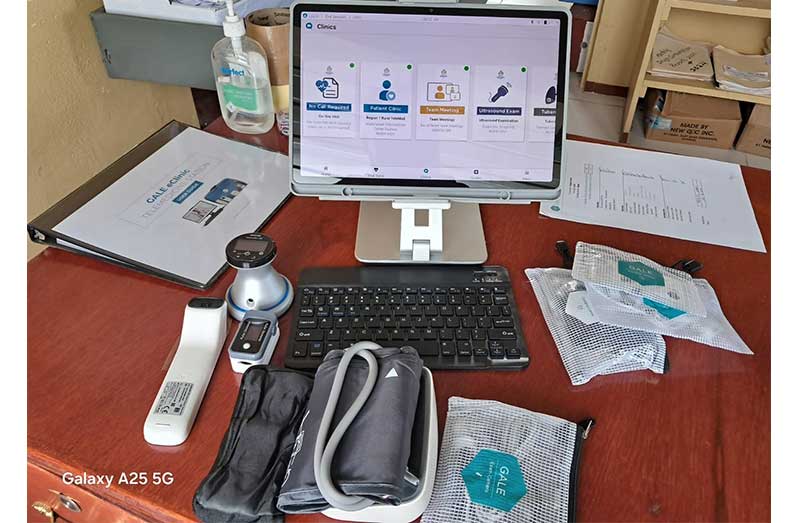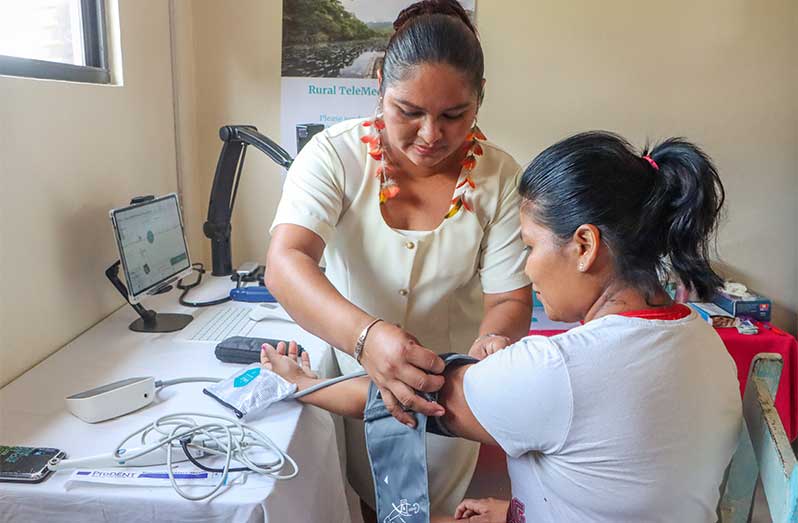IN parts of Guyana that were once isolated by distance, something has changed; a quiet revolution is connecting patients to the care needed through the use of technology.
At the centre of this change is telemedicine, also known as ‘telehealth’, which employs the use of telecommunications technology to deliver healthcare services remotely. It provides remote clinical services through real-time communication using electronic audio and visual means.

This digital lifeline was launched in Guyana in 2022, connecting the health posts and clinics in some of the most remote and hard-to-reach communities to doctors and specialists at regional hospitals and the country’s main referral institution, the Georgetown Public Hospital Corporation (GPHC).
Since its introduction, some 81 sites have been established across the country’s administrative regions.
Providing significant benefits for those communities, Verlina Conrado, a Registered Midwife stationed at Paruima in Region Seven, told the Guyana Chronicle in an exclusive interview that this lifeline has been helpful to their community.
Prior to the implementation of the programme, Conrado stated that it was difficult for workers at the hospital to make contact with the district hospital.
“Now having this, this equipment and all the instruments that came along with it, we have the blood pressure monitor, the thermometer, the oximeter and the otoscope. So, it came in a whole. We have been using that and it has been helping our members here,” she said.
The midwife went on to note that with the system in emergency cases, they are able to contact the doctor stationed at the Kamarang District Hospital.
She added, “Right away, the doctor is on, and we would be able to discuss the patient as if we’re speaking face-to-face with the doctor here at Paruima. We would tell him all the patients’ problems.
Against this backdrop, she disclosed that since many more persons in the community have learned about the system, more persons are coming to the health post to seek care as opposed to travelling to facilities located further away.
Prior to this, residents travelled some three to six hours to Kamarang by boat.
“Now we’re starting to see them coming more now and being able to be seen by on-call doctors,” she said.
Adding another element to being able to provide care, Conrado stated that they are now able to create a patient profile for persons who come to seek care. This enables them to keep patient
information on hand in a confidential manner, allowing them to manage their health history effectively.
The system has also played a pivotal role in the administration of care in White Water Village in Region One, with a population of just around 2,000 persons, which is one of the northernmost villages, located close to Guyana’s border with Venezuela.

For Vybert Vazroz, a Medex stationed at the White Water Health Centre, the system has been an irreplaceable support for the staff there.
“So, it creates a support system for me overall to communicate with my subordinates and also my superiors and also any specialist we might need,” he said.
Adding to this, he said that they have had cases where they would have had to reach out to ophthalmology specialists for patients with eye issues, psychiatry, gynaecology, among many other specialties.
He affirmed, “So it’s a lifeline to me basically in my field of work.”
A RESOUNDING SUCCESS
The implementation of telemedicine here began as a pilot project with nine sites where the Ministry of Health sought to test the concept out.
In an exclusive interview with this publication, Minister of Health Dr Frank Anthony stated that they quickly realised during the pilot phase that this was something that could help improve the quality of care that is being delivered to those remote communities.
In the initial stages of getting the project underway, the health minister noted that there were significant challenges as many of these communities were hard to reach, and as such, transporting the necessary equipment, among other things, was difficult.
The first site, which was set up, he disclosed, was in Masakenari, commonly known as Gunns, one of the country’s most remote communities. The village was able to connect to the GPHC and three other villages.
Despite the initial logistics challenges, the programme has thus far been hailed a success as over the years, quite a number of lives have been saved with the immediate access to care that in some cases had been quite limited before.
He too disclosed that in many villages, people have been responding positively as they have highlighted, they no longer have a need to travel outside of their communities.
TECHNOLOGY
Meanwhile, giving an idea of the type of technology that is being used, Dr Anthony stated that there is a laptop computer at the health centres/posts which is then connected to a number of internet-enabled devices.

Powered by solar energy, the devices connect to the internet through Starlink, which is the best solution for remote locations.
“That is why we’re able to do real-time communication with the various sites, and that has been extremely helpful for the medical personnel working with these sites, and of course, the patients who are the main beneficiaries,” he said.
The system, known as GALE eClinics, piloted by California-based 19Labs, replicates the full clinical experience as a point-of-care platform that offers seamless consultation, diagnostic testing and further patient monitoring.
The platform was designed to be operated by non-healthcare professionals in locations with limited infrastructure and has been optimised for low bandwidth areas.
PLANS FOR EXPANSION
With the benefits of the programme evident, the health minister revealed that there are plans to expand the number of sites across the country.
“We’re planning to expand, we want to increase this to maybe 150 sites and even go further, and at some point in the future, the idea is that every one of our health facilities would be connected,” he said.
Further to this, with the roll out of the ministry’s broader digital health strategy, the telemedicine system is expected to be integrated with the electronic health records system that is being introduced in its early stage at the GPHC.
Dr Anthony added, “Last year, we invested a lot of time into developing a digital health strategy, so part of the digital health strategy is how do we expand telemedicine, how do we use the different applications for telemedicine, so that we could improve care in rural communities.”
In the further advancement of telemedicine, 19Labs, through a partnership with the Inter-American Development Bank (IDB), has launched the pilot project which focuses on using drone technology to deliver medication and medical supplies to hinterland communities.
According to the IDB, this initiative will enhance the country’s expanding telemedicine and digital health network to provide a cost-effective, long-range, two-way drone delivery system that can transport medical supplies in geographically isolated regions.
The pilot project is set to benefit some 20,000 residents who are served by some 15 telemedicine sites in Guyana’s most hard-to-reach communities.



.jpg)












